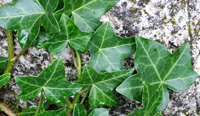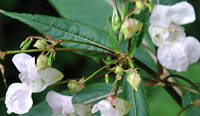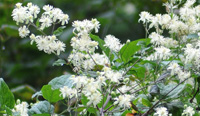The City’s Invasive Plant Management Strategy, adopted by Council in 2013, guides the management of invasive plants on public lands and facilitates the management of invasive plants on private lands. The purpose of the Invasive Plant Management Strategy (Strategy) is to provide the City with an efficient, cost effective, coordinated approach to managing invasive plants.
The goals of the Invasive Plant Management Strategy are to have an effective, adaptable strategy that will:
- Outreach and Education: Increase awareness & knowledge of invasive plants within the community;
-
Control Implementation: Measurably reduce invasive plant density & distribution;
-
Stakeholder Coordination: Coordinate efforts between all stakeholders & resources;
-
Assessment and Restoration: Effectively monitor, maintain & restore the City’s parks and natural areas; and
-
Policy and Adaptive Management: Develop effective policy and practice adaptive management.
If left unchecked, invasive plant species will continue to spread and further degrade the environment, cause detrimental economic impacts and pose human health risks. By implementing the actions identified in the Strategy the City is anticipated to achieve the goals and thus ensure safe, sustainable, and ecologically healthy areas for the benefit of future generations.
 Giant Hogweed - Heracleum mantegazzinnum
Giant Hogweed - Heracleum mantegazzinnum
WARNING: Exposure to Giant Hogweed's clear watery sap sensitizes the skin to ultraviolet radiation and can result in severe burns and blistering to the affected areas.
If you're exposed to Giant Hogweed:
- Wash the affected area immediately with soap and water
- Keep the area out of the sun for at least 48 hours
- Seek medical advice for burns
Giant Hogweed is an Asian member of the parsley or carrot family. It closely resembles our native plant cow parsnip, except the taller giant hogweed grows up to 6 metres or more. It was first introduced as an ornamental feature plant, but its persistent and invasive characteristics quickly made it an escaping garden pest that has spread throughout the Lower Mainland and North America.
Giant Hogweed has numerous small white flowers clusters in an umbrella-shaped head, with stout, hollow green stems covered in purple spots. Dark green leaves are coarsely toothed in three large segments with stiff underside hairs, and lower leaves can exceed 2.5 metres in length. Mature plants can reach up to 6 metres in height and produce up to 100,000 winged seeds that are viable for up to 15 years.
Giant Hogweed is a highly competitive plant due to vigorous early-season growth, tolerance of full shade and seasonal flooding, as well as its ability to co-exist with other aggressive invasive plant species. In the winter months, when the leaves die back, the soil is exposed to winter rains causing erosion in adjacent streams.
If you find Giant Hogweed on your property, due to health concerns residents are not advised to handle Giant Hogweed plant material. Instead, contact the BC Landscape and Nursery Association to find a contractor to remove the plant on your property. Please note, removed plant parts should be disposed on in a sealed garbage bag and not placed in the City's Green Can program.
Resource Links

Japanese Knotweed - Polygonum cuspidatum
Introduced from Asia in the 1800's, Japanese knotweed was considered an attractive and harmless shrub. However, through the ever-increasing disturbance of natural areas, this aggressive perennial soon established its invasive foothold. Reaching heights of up to 3.3m (10 ft) tall, Japanese knotweed has the ability to over-shadow and out-compete all plants within its reach, reducing the ecological integrity of an area. It can now be found growing anywhere including waste sites, along roads, in meadows and wooded areas and along streambanks.
It has small green-white flowers grow in showy plumes off stem and leaf joints. Its stems are hollow and bamboo-like, with reddish-brown speckles. The leaves are heart-shaped and 8-10 cm across and there is a zig-zag pattern of leaf arrangement on the stem. It can grow over 3 metres in a year.
If allowed to grow unmanaged, the plant can grow into dense monocultures which contribute to:
- Slope instability and increased erosion of stream banks.
- Over widening of stream/ditches which undercut existing roadways.
- Damage to asphalt, tarmac, sewerage and infrastructure.
- Degradation of environmental values like poor water quality and decline of native birds, insects and plants.
Knotweed can grow through cement, house foundations, and walls. Its extensive root systems are capable of re-sprouting even after many years of control and roots can break off and float downstream to form new infestations.
Resource Links

English Holly - Ilex aquifolium
English holly is an escaped ornamental species common in North Vancouver and is known to invade upland forests and the edges of wetland areas. It is found throughout Mahon Park.
English holly damages riparian forests and native vegetation by consuming more nutrients than it replaces. The leaves are slow to decompose, hence nutrients are biologically unavailable to other native plant species.
English Ivy - Hedera helix 
English ivy is an evergreen vine native to European forests and introduced into North America around 1723 as a horticultural plant. Unfortunately English ivy has not remained in the environment for which it was intended. It has spread to many natural areas and is increasingly becoming recognized as a danger to natural ecosystems.
Resource Links

Goutweed, Bishop's weed or Ground elder - Aegopodium podagraria
Bishop's weed is an aggressive groundcover that spreads by rhizomes and provides a dense canopy of foliage up to 12" in height.
Small white flowers are produced in umbels similar in form to Queen Ann's lace, but aren't as showy. It quickly develops into a dense groundcover suppressing Native plants.

Himalayan Balsam or Policeman's Helmet - Impatiens glandulifera
Himalayan Balsam is native to the Himalayan region of Asia. It has escaped garden cultivation to invade many areas, predominantly river edges, riparian areas and wetlands.
This pretty pink flowering invader is currently found throughout the Lower Mainland and Fraser Valley of BC. Policeman's helmet is wreaking havoc upon native plants with devastating effects. Each plant can produce up to 800 seeds that burst from mature seedpods travelling over 21ft (7m).
Resource Links
Himalayan Blackberry - Rubus armeniacus
Contrary to its common name, Himalayan blackberry is a native of western Europe. It was probably first introduced to North America in 1885 as a cultivated crop. By 1945 it had become naturalized along the West Coast. Himalayan blackberry occurs mainly in areas with an average annual rainfall greater than 76 cm, at altitudes up to 1800 m, on both acidic and alkaline soils. The shrubs appear as "great mounds or banks" suffocating native vegetation.
Resource Links

Old Man's Beard Clematis - Clematis vitalba
Clematis has become a serious problem in some areas in Mahon Park as it has the ability to smother and eventually bring down large trees.
Attractive, scented creamy-white flowers in summer are followed by seeds with long, fluffy hairs, which can be spread either by wind or by floating on water.

Periwinkle - Vinca minor
Common periwinkle is native to Europe and was first introduced into North America in the 1700s as an ornamental. It is still commonly sold as an ornamental ground cover.
This trailing vine reaches lengths up to 3 feet. The stems are slender, somewhat woody and green in colour. The opposite, glossy leaves are approximately 1 inch long and narrowly elliptical in shape. Some varieties have variegated leaf colours. Flowers are violet to blue (possibly white) in colour, 1 inch wide, and 5-petaled. Common periwinkle invades open to shady forests, forming dense and extensive mats along forest floors that exclude native vegetation.
Resource Links

Yellow Archangel - Lamiastrum galeobdolon
Lamiastrum is sold in nurseries and garden stores as a desirable ornamental vine for hanging baskets but once Lamiastrum gains a foothold outside of a hanging basket arrangement, it is very difficult to keep under control. Beautiful as it is, this trailing creeper has the tendency to sneak over backyard fences and invade our natural area. By forming a dense blanket of leaves, it out-shades practically every other plant on the forest floor.
Resource Links
Noxious weeds are invasive species recognized by the BC government as highly destructive, competitive, and difficult to control. Like other invasive species, they are non-native plants that have been introduced to BC without the predators that help keep them in check in their native habitats.
The BC Weed Control Act imposes a duty on all land owners to control designated noxious weeds. As such, the City is required under the BC Weed Control Act to control these species.
In 2011, eighteen species were added as provincially noxious under the B.C. Weed Control Act, including the following species significant to the City:
- Giant hogweed (Heracleum mantegazzianum)
- Knotweed, Bohemian (Fallopia bohemica)
- Knotweed, Giant (Fallopia sachalinensis)
- Knotweed, Himalayan (Polygonum polystachyum)
- Knotweed, Japanese (Fallopia japonica)
Due to this designation, combined with the results of the Invasive Inventory, Giant Hogweed and Knotweed species have been identified as the City's highest priority species. These species pose public health risks, present slope stability concerns, and can damage buildings and infrastructure.
The City’s management approach uses multiple tools, including:
- Education & Outreach
- Control
- Hogweed and knotweed control contractors – only herbicide treatment in the City*
- City crew activities – manual control of English ivy (especially cut from trees), Clematis, Hops, Scotch broom, English holly
- Stakeholder Coordination
- Collaborating with other agencies, including the Districts of North and West Vancouver, Metro Vancouver, BC Parks, BC Hydro, Squamish Nation, and the Provincial Ministry of Transportation
- Actively involved in the development of the Regional Invasive Species Management Strategy & an active participant in Metro Vancouver’s Invasive Species Task Force
- Assessment & Restoration
- Adaptive Management
- Ongoing monitoring & follow-up will be the key to successful management
- The City has developed AlienMap, an internal web application for tracking all control efforts.
The City uses an Integrated Pest Management (IPM) approach when managing invasive species. This includes extensive monitoring and both manual and chemical (herbicide) control treatment.
Limited applications of herbicide (glyphosate) are used for hogweed and knotweed only, because manual removal of these plants can be more damaging to the habitat than the use of a targeted herbicide. For example, knotweed can grow up to 3 meters below grade and up to 20 metres laterally. Small fragments of knotweed the size of a thumbnail, if left behind in the soil, can easily regenerate.
Herbicides and other pesticides are not otherwise used in the maintenance of the City’s parks and natural areas.
Here are some things that you can do to help target invasive species:
- Never dump garden waste or hanging baskets into parks or other natural areas.
- Dispose of all plant material through the City's Green Can Program (except Hogweed).
- Avoid buying plants promoted as fast spreaders or vigorous self-seeders, as they are often invasive.
- Contain or remove invasive plants on your property to prevent them from spreading.
- Report invasive species to the Invasive Species Council of BC.
- Control weeds that grow under bird feeders. The falling birdseed can become a source of invasive plants.
- Read the Grow Me Instead Guide to learn about BC's most ’unwanted’ plants, along with recommended alternatives.
- Use caution when ordering plant seeds over the internet or through catalogues. The introduction of foreign seeds is a significant route for invasive plants to find their way into the City.
- Grow native plants in your garden – for more information contact the Native Plant Society of British Columbia.
- Get involved - check out the volunteering opportunities with the City Park Stewards and other community groups in the City.